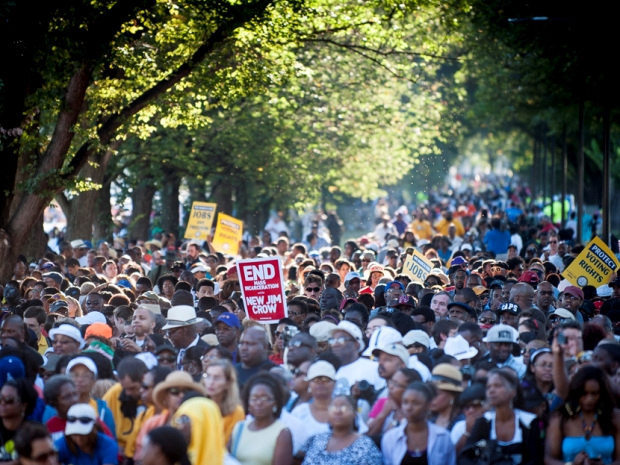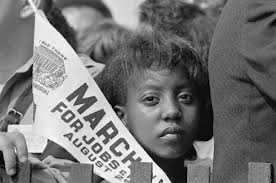
Like many others living here in the US, I’ve been riveted by the 50th Anniversary of the original 1963 March on Washington for Jobs and Freedom while also seeking to understand the relevance of this today.
At the March this year, five women spoke and yet these women represented, at most, 20% of the speakers.
Where were the other women and what were their memories, views, hopes and dreams?
During the 1963 March on Washington, women such as Rosa Parks and Dorothy Height marched down Independence Avenue, while men walked down Pennsylvania Avenue, where the media congregated.
Why was there gender segregation in the March when the intention was to protest segregation?’
It’s important to pay attention to these questions because fighting for justice on one front without ensuring gender inclusivity in the design and execution of these campaigns and this movement building won’t necessarily lead to better outcomes for women and girls. Women’s human rights are part of the civil rights conversation, not separate from it. The situation faced by a black woman will be different to that faced by a black man in terms of security, opportunity, access and choice.
 As we know, the March on Washington for Jobs and Freedom in 1963 was the culmination of decades of organizing by a diverse, and often divided, coalition of organizations, churches and civil rights leaders. The Civil Rights movement was probably the most successful citizens’ movement in U.S. history, certainly of the last century. It was based on organizing, on working door to door, neighborhood to neighborhood, to empower the cause of equality, in the face of real violence. It was a movement that included lunch counter sit-ins, freedom rides, and the dangerous and violent march across the Edmund Pettis Bridge. It involved women and men organizing together, requiring both physical presence and physical risk. And this non-violent movement for change culminated in the Civil Rights Act of 1964 and the Voting Rights Act of 1965.
As we know, the March on Washington for Jobs and Freedom in 1963 was the culmination of decades of organizing by a diverse, and often divided, coalition of organizations, churches and civil rights leaders. The Civil Rights movement was probably the most successful citizens’ movement in U.S. history, certainly of the last century. It was based on organizing, on working door to door, neighborhood to neighborhood, to empower the cause of equality, in the face of real violence. It was a movement that included lunch counter sit-ins, freedom rides, and the dangerous and violent march across the Edmund Pettis Bridge. It involved women and men organizing together, requiring both physical presence and physical risk. And this non-violent movement for change culminated in the Civil Rights Act of 1964 and the Voting Rights Act of 1965.
As John Lewis described it,
“People had been sitting in lunch counters, standing in at theatres. People had been arrested and jailed by the thousands. People had been beaten. Bull Connor, the police commissioner of the city of Birmingham, had used dogs and fire hoses on children and women in the streets of Birmingham. Thousands of young people, and young children, had been arrested and jailed in the city of Birmingham. People couldn’t register to vote simply because of the color of their skin. Back in 1961, ’62, ’63, people had to pass a so-called literacy test in my native state of Alabama. On one occasion, a man was asked to count the number of bubbles in a bar of soap… black doctors, lawyers, college professors, high school principals, maids, sharecroppers, tenant farmers, stood in unmovable lines all across the South. They were denied the right to participate simply because of the color of their skin.”
Who would have thought that half a century later we would still be struggling with issues including voting rights and new threats to freedom in all its dimensions? Today we’re facing a deepening economic divide between the rich and poor. We’re engaged in an intense conversation about immigrant rights where ‘The Dreamers’, those fighting for immigration reform, have provided their own compelling narrative. And we’re involved in an urgent campaign to reclaim women’s sexual and reproductive rights at a time when they’re being rescinded in many states where there is a Republican majority.
One of Martin Luther King’s great gifts to us was to invoke the activist tradition. Congressman John Lewis’s compelling oratory for the 50th Anniversary March on Washington ended with his own call to action where he said,
“You cannot stand by. You cannot sit down. You have to stand up, speak up, speak out and get in the way. Make some noise. The vote is precious. It is almost sacred. It’s the most powerful non-violent tool we have in a democratic society and we’ve got to use it.”
In recalling the 1963 March, Lewis said “We wanted to build what we called the beloved community, a community at peace with itself. And we truly believed there’s a spark of the divine in every single one of us and that you don’t have a right to…destroy that spark. It was not a black march. We wanted everyone to participate. We wanted to…move toward the creation of an America at peace with itself, the beloved community, where no one would be left out or left behind. And it didn’t matter your race or your color.”
Maya Angelou is one woman who played a leadership role in the civil rights movement in the lead up to the March on Washington. While in Ghana, she met with Malcolm X and in 1964 she returned to America to help him build his new Organization of African American Unity. Shortly after her arrival in the United States, Malcolm X was assassinated, and the organization dissolved. Soon after X’s assassination, she was invited by Dr Martin Luther King Jr. to serve as Northern Coordinator for the Southern Christian Leadership Conference and King’s assassination, falling on her birthday in 1968, left her devastated. With the guidance of her friend, the novelist James Baldwin, she began work on the book that would become I Know Why the Caged Bird Sings that was published in 1970 to great acclaim.
It was the great gospel singer, Mahalia Jackson, who sang just before King began to speak at the March on Washington, who shouted to King “Tell ‘em about the dream, Martin, tell ‘em about the dream!” midway through his scripted speech. It was at that point that King ad-libbed and, with this speech, captured the attention and imagination of the crowd, the country, and indeed of the world. King was appealing to America’s values as a nation, which is still the appeal that John Lewis makes today when he says, “We need a revolution of values. We need a revolution of ideas. We need to humanize.”
How to address the root causes of poverty and injustice is critical to real social change. Harvard professor, Marshall Ganz, says that movements have narratives and they rearrange meaning. Movements are about “building enough of a constituency that you can develop the power you need in order to achieve what you want. And so what you’re doing is engaging people, who engage other people, who engage other people.”
Ganz refers to the risk-taking, uncertainty and faith required in movement building and how movements draw strength from narratives, storytelling, creativity and the identity work within all faith and cultural traditions. He makes a distinction between tactics and strategy as well, citing the Occupy Movement as a tactic without a strategy. As he says, to build a movement you need story, strategy and structure. The strategy is the theory of change and how you’re going to influence those sources of power and your structure is the means by which you’re going to achieve it.
In talking to Bill Moyers, Ganz speaks about inequality of power as being a defining feature of American life today. One could easily extend this to the situation for women in most parts of the world being defined by this inequality of power, including political and economic inequality. Ganz also talks about the free market being the dominant narrative in American culture – again one could extend this to a globalized world. The question Ganz poses is “where’s the missing alternative counter to that? I think that is an enormous intellectual challenge for our time right now. Where’s that alternative?”
BILL MOYERS: We need a new story?
MARSHALL GANZ: We need a new story. ..It’s also a new way of describing our economic challenges and our political challenges that emphasizes…the ways in which we cooperate and collaborate with one another.
Recognizing the importance of movements in holding ground as well as gaining ground is vital. In the United States we’re fighting anew for the right to vote and for women to make their own choices regarding their bodies. In this work we’re connected to movements in many other countries where we’re seeing these rights revoked. What has been happening here in the US in terms of a pushback by Republican senators on women’s right to make choices about their bodies is being taken to new levels in countries like Indonesia. In south Sumatra the education chief recently proposed making female high school students undergo mandatory virginity tests each year saying “This is for their own good.”
So what can we do?
In a recent interview, Moyers asked Ganz what influenced his own life choices and Ganz offered the following:
“There were three questions posed by the 1st century Jerusalem scholar Rabbi Hillel, when asked “How do we understand what we are to do in the world?” And he responded with three questions.
The first one is to ask yourself, “If I am not for myself, who will be for me?” It’s not a selfish question, but it is a self-regarding question. Sort of saying, “Ask yourself what you’re about, what you value, what you have to contribute …”
The second question is, “If I am for myself alone, what am I?” (this)…is to recognize that we are in the world in relationship with others and that our capacity to realize our own objectives is inextricably wrapped up with the capacity of others to realize theirs.
And finally, “If not now, when?” The time for action is always now, because it’s often only through action that we can learn what we need to learn in order to be able to act effectively in the ways that we intend. And the fact that they’re questions is also really important to me, because it suggests that this work, this work of organizing, leadership is not about knowing, it’s about learning.”
[symple_testimonial by=”Martin Luther King Jnr.”]Let us develop a kind of dangerous unselfishness…The question is not, “If I stop to help the sanitation workers, what will happen to my job?”….The question is, “If I do not stop to help the sanitation workers, what will happen to them?” That’s the question…Let us rise up tonight with a greater readiness. Let us stand with a greater determination. And let us move on in these powerful days, these days of challenge to make America what it ought to be. We have an opportunity to make America a better nation.
Jane Sloane – San Francisco